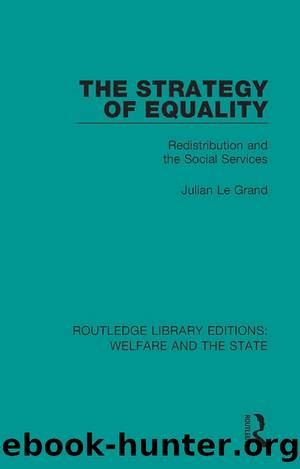The Strategy of Equality by Julian Le Grand

Author:Julian Le Grand [Grand, Julian Le]
Language: eng
Format: epub
Tags: Social Science, Sociology, General
ISBN: 9780429944222
Google: JmEPEAAAQBAJ
Barnesnoble:
Goodreads: 3867342
Publisher: Routledge
Published: 1982-01-01T00:00:00+00:00
The Distribution of Costs
Not surprisingly, the difference in public subsidy detailed in the previous sections creates differences in the private cost per âunitâ of housing that each household faces. Professors Atkinson and King of the CLARE group of economists have recently produced an important analysis of the way in which money housing costs vary between different groups in the population (King and Atkinson, 1980); much of the following is based on their analysis.12
The cost of housing services to a tenant is simple to specify: his rent plus any maintenance expenses he had to bear. The cost of a house to an owner-occupier is more complex to assess. It has several components. First, there is the opportunity cost of his âequityâ, that is, the income (after tax) he could receive if he took the capital he has invested in the house and invested it in some other form, such as government securities. Then the cost of any mortgage he has must be taken into account, that is, the interest payments on the mortgage, less any tax relief he received on those payments, plus the costs of maintenance. But this is not the complete picture. All of these increase his costs, but there is another factor which decreases it. House owners have an asset whose value increases over time. Hence they make capital gains, which offset in whole or in part the other items of cost.
To summarise, the cost of housing services to an owner-occupier consists of the after-tax return on alternative investment of his equity, plus the after-tax interest payments on any mortgage, plus maintenance costs minus any capital gain. An algebraic formulation is given in a note.13
Now these costs will vary according to the owner-occupierâs marginal tax rate (the rate of tax he pays on any extra income he receives) and the size of his mortgage. King and Atkinson have calculated these costs for a variety of different cases. Some of their estimates, adjusted to include average maintenance costs for owner occupiers, are shown in Table 5.3.
Table 5.3 Annual Housing Costs to Owner-Occupier of £10,000 House
Annual Housing Costs (£ âs) United Kingdom, 1977
Percentage of value of house mortgaged Marginal tax rate of owner-occupiers (%)
30 40 50 60
80% 202 76 â 50 â 176
20% 328 184 40 â 104
Note: Mortage interest rates assumed to be 12 per cent; rate of increase of house prices, 8 per cent; opportunity cost of ownerâs equity, 15 per cent; average annual maintenance costs for owner-occupiers, £120 (Department of Employment, 1978,Table 1, p. 21); mortgages below £25,000 ceiling.
Source: Calculated from King and Atkinson (1980, p. 10, Table 3).
From this table it is immediately apparent that costs are less, the larger the mortgage and the tax rate. Indeed, some of the cases illustrated (such as those with an 80 per cent mortgage facing 50 or 60 per cent marginal tax rates) actually have negative costs; in other words, they are being paid to live in their accommodation.
Moreover, these costs are almost certainly less than the costs of living as a tenant, either of a local authority or a private landlord.
Download
This site does not store any files on its server. We only index and link to content provided by other sites. Please contact the content providers to delete copyright contents if any and email us, we'll remove relevant links or contents immediately.
The Secret History by Donna Tartt(18843)
The Social Justice Warrior Handbook by Lisa De Pasquale(12141)
Thirteen Reasons Why by Jay Asher(8792)
This Is How You Lose Her by Junot Diaz(6794)
Weapons of Math Destruction by Cathy O'Neil(6142)
Zero to One by Peter Thiel(5685)
Beartown by Fredrik Backman(5595)
The Myth of the Strong Leader by Archie Brown(5424)
The Fire Next Time by James Baldwin(5248)
How Democracies Die by Steven Levitsky & Daniel Ziblatt(5127)
Promise Me, Dad by Joe Biden(5087)
Stone's Rules by Roger Stone(5026)
A Higher Loyalty: Truth, Lies, and Leadership by James Comey(4843)
100 Deadly Skills by Clint Emerson(4840)
Rise and Kill First by Ronen Bergman(4701)
Secrecy World by Jake Bernstein(4644)
The David Icke Guide to the Global Conspiracy (and how to end it) by David Icke(4624)
The Farm by Tom Rob Smith(4434)
The Doomsday Machine by Daniel Ellsberg(4415)
